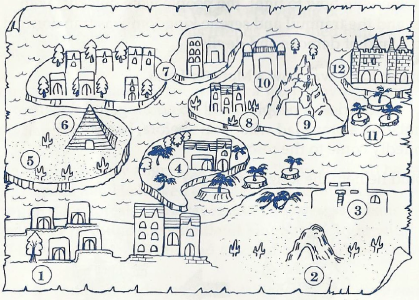DoABarrelRoll
Novice
The Origin of Wonder Boy

Let's explore the fascinating story behind a true classic: Wonder Boy In Monster Land or Mônica no Castelo do Dragão, discovering its origins, influences, and its legacy. I'm going to focus on the official location of Tectoy Mônica no Castelo do Dragão because it's the version I played the most, but remembering that the game is practically the same, with just a few graphical changes.
It all started with the first game in the Wonder Boy series which is a 1986 platform game published by Sega and developed by Escape (later Westone Bit Entertainment).
The game was originally designed for arcades and then ported to Sega's 8-bit consoles. In it Tom-Tom goes on a long adventure to chase King, and rescue his girlfriend, Tina.
Adaptations

SEGA owned the rights to the "Wonder Boy" trademark, while Westone still had the rights to the original game code. They decided to license their concept to Hudson Soft, who in turn would port the Wonder Boy games to Sega's competitors. This allowed them to earn a small royalty fee for each console port sold, while maintaining good relations with Sega. Hudson Soft adapted the first Wonder Boy for Nintendo's 8-bit system under the name Adventure Island which became its own series independent of Westone's games.
After the success of the first "Wonder Boy", the team at Westone, responsible for the original game, began planning a sequel.
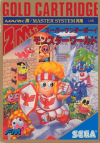
The creation of the game Wonder Boy in Monster Land by Westone Bit Entertainment was influenced by various sources and inspirations of the time.
It was part of the golden age of arcades, when arcade games were on the rise and always sought to attract players by offering an engaging and challenging experience.
The RPG aspect of Wonder Boy in Monster Land was influenced by Wizardry and other role-playing games of the 1980s. The game incorporated elements such as character progression, purchasing items, and exploring fantasy worlds.
The combination of elements from different genres, such as platform and RPG, was a way to differentiate Wonder Boy in Monster Land from other games at the time.
The game became a classic due to its innovative gameplay and its appeal to video game fans of the time.
History
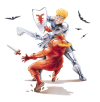
In the arcade version Wonder Land is a vast blessed land where the inhabitants live happily. However, misery suddenly strikes everyone when monsters led by an evil dragon invade and conquer the land. The peaceful land was now known as "Monster Land", and humans always live in fear and in hiding. So the brave young "Bock or Tom-Tom” (depending on the game's location) decides to embark on a journey to defeat the dragon.
In Mônica's version, Captain Ugly, the Master of Manholes, gathered an army of monsters with the Fire-Breathing Dragon as his right-hand man. Only Mônica and her bunny Sansão can stop Captain Ugly's plan. Interestingly, Captain Ugly only appears in the opening screen, even though he is the story's main villain.
Ports
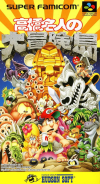
Mônica no Castelo do Dragão is a small modification of the North American version of Monster Land, released in 1991 on the Brazilian Master System by Tectoy (a Brazilian company that imports and distributes electronic products). The changes include the title screen, the story, the main character being Mônica and the sword being replaced by her stuffed bunny Sansão. Tectoy even made several adaptations of the Wonder Boy series for the Brazilian market, all involving the characters from Turma da Mônica.
Gameplay
The game itself involves controlling the hero in various stages, facing enemies and acquiring equipment. There are stores to buy items, spells and improvements, as well as secrets hidden throughout the levels. The game combines platform elements with RPG, offering a dynamic experience.
The game's graphics were good for the time, with vibrant colors, a good number of sprites, well-designed enemies and a good number of characters on the screen. Everything is very clear and matches the theme of the game.
Music

Newly hired composer Shinichi Sakamoto faced technical challenges due to primitive audio technology. His approach was to create a chorus effect by layering two channels with a slightly distinct tone, resulting in a richer, fuller sound. Thanks to this cunning and his engaging musical compositions, Sakamoto managed to successfully incorporate one of the components for which the series stood out: its soundtrack.
Levels
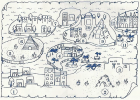
In Monster Land The arcade version has 11 levels, and the Master System version has 12 levels. The developers planned to include a World Map between levels, but it was only in the instruction manual.
Difficulty

The game is not only fun, it is also known for being quite difficult. Enemies only give you money the first time you defeat them. In other words, you cannot save money.
His attack is also very short, any mistake will result in damage to the character.
You only have one life, if you lose all your hearts - you will be automatically revived once, after that, it's game over.
Hidden Surprises
The game also has several hidden surprises to discover, which adds to its charm. There are plenty of treasures and secret passages to be discovered. When you get them all, you will have the option to choose between two crucial items in the game's outcome: a Ruby or a Bell. The Ruby will make the battle against the last boss, the dragon, a little more accessible, while the bell serves as an essential guide to the last phase, a complex maze.
To be prepared and equipped in the best possible way for the final battle, it is essential to know every detail of the game. This is only achieved through repeated attempts and practice, as you need to know where to find money, what to buy, and when to make these choices in advance. The general difficulty is high, attacks have limited range and most enemies are agile and can easily surround you.
Despite the difficulty, the game has a quality that many other games do not have, which is the ability to make the player want to play it again and overcome their own limits. Progressive difficulty always stimulates the desire to advance.
Conclusion
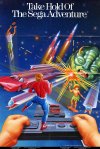
Wonder Boy in Monster Land is an interesting story where the console version was more successful than its arcade version, the game was one of the main ones in the Master System catalog, a console that was more successful in Europe and South America than in the rest of the world, much of this is due to the fantastic NES that had revitalized the console market in the 80s after the great gaming crash caused by Atari.
As Nintendo had exclusive contracts with game producers, they could not produce games for any other device, making the Master System depend mainly on releases developed by Sega.
Even so, the console received great games and marked the childhood of several gamers who had the opportunity to own a Master System.
For those who like a good challenge and don't mind replaying a few times until they memorize what to do, Wonder Boy In Monster Land presents a very fun experience.

Let's explore the fascinating story behind a true classic: Wonder Boy In Monster Land or Mônica no Castelo do Dragão, discovering its origins, influences, and its legacy. I'm going to focus on the official location of Tectoy Mônica no Castelo do Dragão because it's the version I played the most, but remembering that the game is practically the same, with just a few graphical changes.
It all started with the first game in the Wonder Boy series which is a 1986 platform game published by Sega and developed by Escape (later Westone Bit Entertainment).
The game was originally designed for arcades and then ported to Sega's 8-bit consoles. In it Tom-Tom goes on a long adventure to chase King, and rescue his girlfriend, Tina.
Adaptations

SEGA owned the rights to the "Wonder Boy" trademark, while Westone still had the rights to the original game code. They decided to license their concept to Hudson Soft, who in turn would port the Wonder Boy games to Sega's competitors. This allowed them to earn a small royalty fee for each console port sold, while maintaining good relations with Sega. Hudson Soft adapted the first Wonder Boy for Nintendo's 8-bit system under the name Adventure Island which became its own series independent of Westone's games.
After the success of the first "Wonder Boy", the team at Westone, responsible for the original game, began planning a sequel.

The creation of the game Wonder Boy in Monster Land by Westone Bit Entertainment was influenced by various sources and inspirations of the time.
It was part of the golden age of arcades, when arcade games were on the rise and always sought to attract players by offering an engaging and challenging experience.
The RPG aspect of Wonder Boy in Monster Land was influenced by Wizardry and other role-playing games of the 1980s. The game incorporated elements such as character progression, purchasing items, and exploring fantasy worlds.
The combination of elements from different genres, such as platform and RPG, was a way to differentiate Wonder Boy in Monster Land from other games at the time.
The game became a classic due to its innovative gameplay and its appeal to video game fans of the time.
History

In the arcade version Wonder Land is a vast blessed land where the inhabitants live happily. However, misery suddenly strikes everyone when monsters led by an evil dragon invade and conquer the land. The peaceful land was now known as "Monster Land", and humans always live in fear and in hiding. So the brave young "Bock or Tom-Tom” (depending on the game's location) decides to embark on a journey to defeat the dragon.
In Mônica's version, Captain Ugly, the Master of Manholes, gathered an army of monsters with the Fire-Breathing Dragon as his right-hand man. Only Mônica and her bunny Sansão can stop Captain Ugly's plan. Interestingly, Captain Ugly only appears in the opening screen, even though he is the story's main villain.
Ports

Mônica no Castelo do Dragão is a small modification of the North American version of Monster Land, released in 1991 on the Brazilian Master System by Tectoy (a Brazilian company that imports and distributes electronic products). The changes include the title screen, the story, the main character being Mônica and the sword being replaced by her stuffed bunny Sansão. Tectoy even made several adaptations of the Wonder Boy series for the Brazilian market, all involving the characters from Turma da Mônica.
Gameplay
The game itself involves controlling the hero in various stages, facing enemies and acquiring equipment. There are stores to buy items, spells and improvements, as well as secrets hidden throughout the levels. The game combines platform elements with RPG, offering a dynamic experience.
The game's graphics were good for the time, with vibrant colors, a good number of sprites, well-designed enemies and a good number of characters on the screen. Everything is very clear and matches the theme of the game.
Music

Newly hired composer Shinichi Sakamoto faced technical challenges due to primitive audio technology. His approach was to create a chorus effect by layering two channels with a slightly distinct tone, resulting in a richer, fuller sound. Thanks to this cunning and his engaging musical compositions, Sakamoto managed to successfully incorporate one of the components for which the series stood out: its soundtrack.
Levels

In Monster Land The arcade version has 11 levels, and the Master System version has 12 levels. The developers planned to include a World Map between levels, but it was only in the instruction manual.
Difficulty

The game is not only fun, it is also known for being quite difficult. Enemies only give you money the first time you defeat them. In other words, you cannot save money.
His attack is also very short, any mistake will result in damage to the character.
You only have one life, if you lose all your hearts - you will be automatically revived once, after that, it's game over.
Hidden Surprises
The game also has several hidden surprises to discover, which adds to its charm. There are plenty of treasures and secret passages to be discovered. When you get them all, you will have the option to choose between two crucial items in the game's outcome: a Ruby or a Bell. The Ruby will make the battle against the last boss, the dragon, a little more accessible, while the bell serves as an essential guide to the last phase, a complex maze.
To be prepared and equipped in the best possible way for the final battle, it is essential to know every detail of the game. This is only achieved through repeated attempts and practice, as you need to know where to find money, what to buy, and when to make these choices in advance. The general difficulty is high, attacks have limited range and most enemies are agile and can easily surround you.
Despite the difficulty, the game has a quality that many other games do not have, which is the ability to make the player want to play it again and overcome their own limits. Progressive difficulty always stimulates the desire to advance.
Conclusion

Wonder Boy in Monster Land is an interesting story where the console version was more successful than its arcade version, the game was one of the main ones in the Master System catalog, a console that was more successful in Europe and South America than in the rest of the world, much of this is due to the fantastic NES that had revitalized the console market in the 80s after the great gaming crash caused by Atari.
As Nintendo had exclusive contracts with game producers, they could not produce games for any other device, making the Master System depend mainly on releases developed by Sega.
Even so, the console received great games and marked the childhood of several gamers who had the opportunity to own a Master System.
For those who like a good challenge and don't mind replaying a few times until they memorize what to do, Wonder Boy In Monster Land presents a very fun experience.

